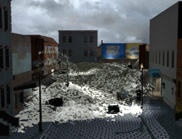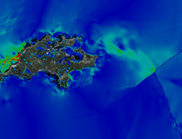Bath time’s over for computer models
It’s time for computer models of tsunamis and storm surges to get out of the bath, according to a CSIRO researcher speaking at the Coast to Coast Conference in Brisbane today. More realistic models are needed for infrastructure planners and emergency managers to better prepare for disasters.
“Our models help us predict quite accurately which coastal areas will be affected and how much damage could occur to specific infrastructure if a disaster happens”
Dr Mahesh Prakash, CSIRO Fluids Modeller
CSIRO fluids modeller Mahesh Prakash said that his team’s maths-based models are more true-to-life than the standard ‘bathtub’ models and that CSIRO leads the world in this area of fluids modelling.
“Our work is a big improvement on the simple ‘bathtub’ computer models which show water levels going up evenly like they do when you fill your bath.
“The reality of a storm surge or tsunami is very different – the water is moving, often with a lot of force and it interacts with things that get in its way,” he said.
With coastal storms increasing in frequency and severity and last year’s tsunami in Japan still in recent memory, understanding coastal inundation processes is more important than ever – and computer models can help.
CSIRO’s models can show how fast the water moves, how soon it reaches natural and man made landscape features, how long it stays at peak levels, the size of the forces it generates on specified buildings, bridges, roads and other structures and whether these structures are recoverable.
“Basically, our models help us predict quite accurately which coastal areas will be affected and how much damage could occur to specific infrastructure if a disaster happens,” he said.
Dr Prakash will demonstrate the models with video clips of a hypothetical tsunami hitting an Australian coastline.
The CSIRO models allow infrastructure planners and emergency managers to better prepare for such disasters by making evidence-based decisions.
Using these models, coastal walls, levees and other structures can be realistically tested on a computer at the design stage to see if they will provide protection to communities under specified conditions.
“Hurricane Katrina, the Japan earthquake and tsunami – these are recent events where some man-made structures failed to protect communities.
We can use computer models to test structures before they’re built and find out which parts of a city are vulnerable. That way we can help decision makers make communities more resilient” he said.
The computer models are the result of more than a decade’s work in computer algorithms and supercomputers.
Media resources
Watch a video of CSIRO computer models visualising the effects of tsunamis and storm surges.
Click image for high resolution version



